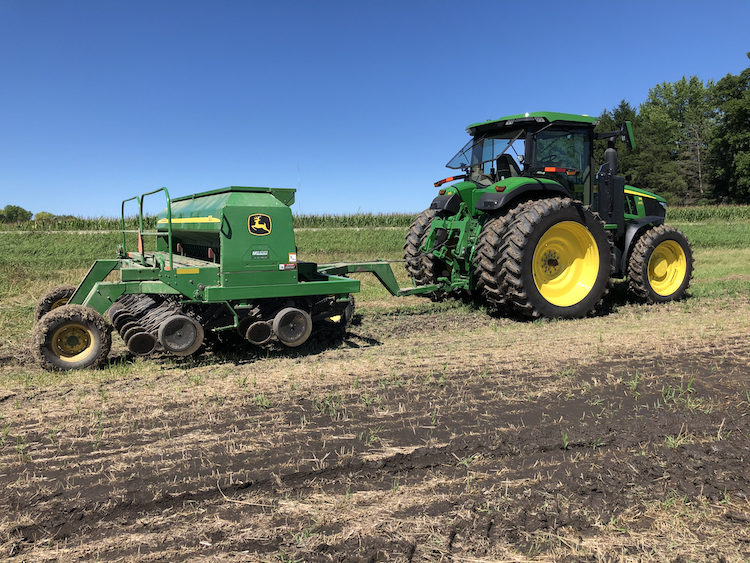Pictured Above: SEED CAPTURE. A plastic baggie attached to the seed tube collects seed during drill calibration. This method involves driving the drill 150 feet, which takes much less time than seeding an acre or more to assess seed usage.
One of the biggest challenges with any crop is getting it established.
While the most impactful factors that affect success are probably weather, planting conditions and growing season, certified forage consultant Brendon Blank of Ixonia, Wis., says seeding at the right rate is also important for success and can be difficult with a drill.
If not enough seed is released, the stand may be too thin and yields can suffer. If too much seed is released, you can run out of seed and costs can soar.
A common approach is to put a few bags of seed in the drill, plant an acre, figure out how much is left and adjust from there, Blank says. But that method is time consuming, not very accurate and can lead to unexpectedly running out of seed.
Most grain drills have a seeding chart that is a good starting point for setting the seeding rate, which will be based on the species or mix being planted as well as the distance between the disc openers.
But a few factors, such as wear-and-tear on the parts over the years, seed size and the presence or absence of a seed coating can cause a drill to release more or less seed than the setting indicates. So Blank suggests calibrating your drill every time you use it.

GRAMS PER ROW. After capturing the seed from the seed tubes, weigh the output of each tube on a simple kitchen gram scale. To calculate a seeding rate not found on the chart, multiply the desired pounds per acre by 0.78 for 6-inch rows, 0.91 for 7-inch rows, 0.98 for 7.5-inch rows or 1.04 for 8-inch rows. ?Source: University of Kentucky
Many county extensions and universities have developed complicated formulas for drill calibration that involve computing pure live seed (PLS) percentages and seeding area square footage, expressed as a fraction of an acre. But Blank says it doesn’t need to be that difficult, as demonstrated by the University of Kentucky’s simplified approach that not only doesn’t involve all that math, but can be boiled down into these five steps:
- Begin by consulting the chart below to determine how many grams of seed should be released from each opener over a 150-foot distance, based on your target seeding rate and row spacing.
- Make sure the seed tubes are free of any debris or insects by blowing compressed air or running a wire through them.
- After setting the drill to the target seeding rate, use a rubber band to attach a plastic baggie to a seed tube to capture the seed that will be released during the calibration test. For a good representative sample, it’s best to take samples from a few tubes so you can assess variance and get an average across the width of the drill.
- Next, mark off a distance of 150 feet from where the drill is resting.
- Drive the drill until you reach the 150-foot marker, collect the seed in the baggie(s), and weigh the bags using a gram scale. Zero-out the scale with an empty bag on it before weighing a bag containing seed to make sure you’re only weighing the seed. Check the chart again to confirm whether or not you need to make any adjustments to your drill settings.
To watch a video on the drill calibration method described here, visit www.No-TillFarmer.com/drillcalibration.
If the amount captured is within about 10% of the desired amount, plus or minus, you’re good to go.
Alternatively, you can leave the drill stationary and turn the drive wheel the number of revolutions it would take to travel 150 feet. To determine the number of revolutions, measure the circumference of the drive wheel in feet, and then divide 150 by that length.
It’s as simple as that. With a properly calibrated drill, you can quickly make sure you’re really seeding your cover crops at the desired rate, instead of leaving it up to guesswork.








Post a comment
Report Abusive Comment